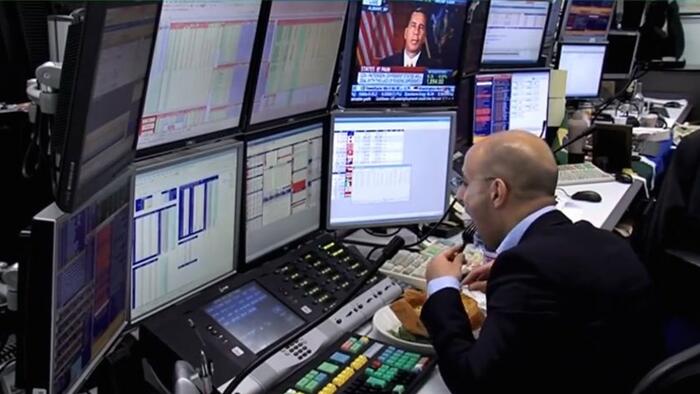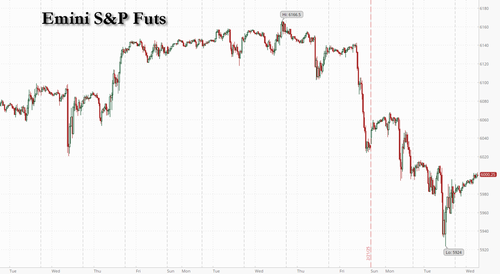


US equity futures are higher, reversing much of yesterday's drop, and European bourses are at all time high, as the market braces for NVDA earnings after today’s close. As of 7:30am, S&P futures are up 0.6% while Nasdaq futures jump 0.8% as all Mag7 names are higher premarket ex-AAPL, while NVDA rises 2.6% aiding the bid for Semis and signaling a rebound on Wall Street after Tuesday’s drop, fueled by a weaker-than-expected consumer confidence print that stirred fears of an economic downturn. Bond yields are 1-2bps higher but with little reaction to the House passing the blueprint for the next budget that is likely to materially increase the deficit. President Trump is set to meet Zelenskiy this week to sign an agreement giving the US control over half of the war-battered country’s natural resources. Elsewhere, China plans to start re-capitalizing several of its biggest banks in the coming months while BP announced it will increase its oil and gas production. The global risk-on tone is not extending to commodities where there is weakness across all 3 complexes. To the day ahead now, and the main highlight will be Nvidia’s earnings after the US close; data releases include US new home sales for January.
In premarket trading, Super Micro Computer soars 25% after the company filed its 10-K for the period ending June 30, 2024, meeting a deadline for submitting outstanding financial reports to regain compliance and stay listed on the Nasdaq. Nvidia is leading premarket gains among the Mag 7 before its much-anticipated fourth-quarter results (Nvidia +2.4%, Tesla +2.0%, Amazon +1.1%, Meta Platforms +1.03%, Alphabet 0.8%, Microsoft +0.6%, Apple -0.5%). Power and electrical equipment companies are trading higher after a report said Meta (+1.03%) was in discussions to build a new data center campus for its AI projects that could cost more than $200 billion (SES AI +7.3%, NANO Nuclear Energy +6.6%, Oklo +7.0%, Vistra +3.7%, Celestica +4.3%, Vertiv +3.1%, Constellation Energy +1.8%, nVent Electric +0.5%). Here are some other notable premarket movers:
All eyes are on Nvidia todaywhich will report after the US market close. The result could determine Wall Street’s direction, especially for the technology sector, after recent months showed AI computing adoption won’t be a straight path. Options data imply share moves of about 10% in either direction around the report.
“The reality is, we need a good set of numbers from Nvidia to keep this bull track in place in the US,” said Guy Miller, chief market strategist Zurich Insurance Co. “It will be important that the numbers are good and the outlook is good. If it’s a really disappointing reading the market will be vulnerable to a further setback.”
Nvidia’s shares rose about 3% in premarket trading, signaling a recovery from the previous session’s 2.8% drop. Shares in the company are down almost 6% year-to-date, after blistering gains in the past couple of years. The concerns have rippled across the technology sector, pushing the Magnificent Seven group of bellwether tech stocks into correction territory on Tuesday.
Europe's Stoxx 600 rises 0.8% to a record high, boosted by solid corporate earnings and optimism around a potential peace deal in Ukraine. Anheuser-Busch InBev shares surged the most in more than three years after growth in organic earnings topped estimates. Basic resources also outperform as copper prices rise on Trump’s tariff threat.
Sentiment was also boosted by strong results from a slew of companies including Banco Santander SA, Fresenius SE and Alcon AG while automaker Stellantis slipped on its latest numbers. Here are the biggest movers Wednesday:
Earlier in the session, Asian stocks were set to gain for the first time in three days after equities in mainland China and Hong Kong staged a strong rally amid a slew of positive developments. The MSCI Asia Pacific Index rose as much as 0.9%. Hong Kong shares rallied strongly, after Chinese AI platform DeepSeek reopened access to its core programming interface after nearly a three-week suspension. Chinese e-commerce giants Alibaba and Meituan were among the top contributors as a meeting between the regulator and some firms was seen as promoting fair competition and improving the market environment. Bank stocks climbed following a Bloomberg News report that China plans to start re-capitalizing several of its biggest lenders in coming months, following through on a broad stimulus package unveiled last year to shore up the struggling economy. Elsewhere, Thailand’s benchmark equity index jumped more than 2% after its central bank unexpectedly cut rates. Equities in Japan fell while Indian markets was shut for a holiday.
In FX, the Bloomberg Dollar Spot Index halves a 0.2% advance as chances for early action on Trump’s tax cut plans improved after House Republicans passed a budget blueprint; month-end flows into the Tokyo fix offered support, also boosted by chances for early action on Donald Trump’s tax cut plans after House Republicans passed a budget blueprint. EUR/USD slips 0.1% to 1.0500, versus 1.0487-1.0525 day range; euro struggles near year-to-date highs and the latest rejection opens up risk for a correction as the volatility skew remains in favor of the greenback across the curve. USD/JPY rises as much as 0.4% to 149.63, before halving the advance; focus on Friday’s Tokyo CPI data. GBP/USD down 0.1% at 1.2656, versus 1.2636 day low; BOE rate-setter Swati Dhingra set to speak.
In bond markets, treasuries halt a five-day rally after House Republicans passed a budget blueprint; Treasury yields rose across the curve with 10-year yields around 4.305% or ~1bp cheaper on the day, trailing bunds and gilts in the sector by 3bp-4bp; front-end underperformance flattens 2s10s spread by ~1bp. 10-year yield initially rose by as much as 4bps before losing traction and steadying after an 11-basis-point decline overnight took it to the lowest level since mid-December. Price action unwinds a portion of Tuesday’s steep flight-to-quality gains spurred in part by soft data and helped by strong demand for 5-year note auction. European government bonds climb, led by OATs with French 10-year yields falling 4 bps to 3.16%. German 10-year borrowing costs fall 2 bps to 2.43%. Money markets have raised their bets on Federal Reserve policy easing, and now price more than two quarter-point interest-rate reductions in 2025. Treasury’s $44b 7-year note auction follows strong demand for 2- and 5-year note sales earlier this week; the WI 7-year yield at ~4.24% is ~22bp richer than January’s, which stopped through by 0.9bp
In commodities, copper futures surged after the latest tariff threat, while gold traded just off the latest all-time high hit on Monday. Spot gold is flat near $2,915/oz. Bitcoin also steadies at around $89,000. Oil prices are treading water, with WTI near $69 a barrel.
Looking at today's calendar, US economic data calendar includes January new home sales and building permits (10am). Fed speaker slate also includes Barkin (8:30am) and Bostic (12pm)
Market Snapshot
Top Overnight News
A more detailed look at global markets courtesy of Newsquawk
APAC stocks traded mixed as a tech rally in China offset the weak handover from Wall St where the Nasdaq led the declines once again and risk appetite was sapped by weak consumer confidence data. ASX 200 was led lower by weakness in mining, materials and consumer staples as participants digested disappointing Construction Work data which feeds into Australia's GDP and with supermarket operator Woolworths pressured post-earnings. Nikkei 225 fell beneath the 38,000 level for the first time this year with the index underperforming following recent currency strength although was off worst levels as the yen then pared some of its recent advances. Hang Seng and Shanghai Comp gained with Hong Kong leading the advances amid tech strength and recent earnings, while Hong Kong continued to record a higher deficit for this year in the Budget and will increase the scale of bond issuances.
Top Asian News
European bourses (STOXX 600 +0.8%) opened stronger across the board and have continued to slowly grind higher as the session progressed; currently at highs. European sectors hold a strong positive bias; Basic Resources is by far the clear outperformer, lifted by strength in metals prices (amid US Commerce Secretary Lutnick's copper comments). Media and Telecoms are both hampered by post-earning losses in Wolters Kluwer (-5%) and Deutsche Telekom (-3.8%) respectively.
Top European News
FX
Fixed Income
Commodities
Geopolitics: Middle East
Geopolitics: Ukraine
Geopolitics: Taiwan
US Event Calendar
Central Banks
DB's Jim Reid concludes the overnight wrap
Markets saw another decent risk-off move over the last 24 hours, as concerns about the US economic outlook continued to mount. There wasn’t a single catalyst, but there’s been some disappointing US data recently, and yesterday we found out that the Conference Board’s consumer confidence indicator hit an 8-month low. By the close, no asset class was immune from the slump, with equities losing ground, credit spreads widening, bond yields falling, and commodities selling off too. In fact, it’s now been the biggest 4-day decline for the S&P 500 since early September, and the Magnificent 7 was back in technical correction territory, having now shed more than -10% since their peak back in December. So that’s heightening the focus on Nvidia’s earnings after the US close tonight. Meanwhile for Bitcoin (-5.59%), it was the biggest daily fall since early September.
In terms of yesterday’s developments, it had looked like markets would start to stabilise again, with the S&P 500 broadly flat at the time of the US open. But a more negative tone quickly began to develop, particularly after the Conference Board’s indicator fell to just 98.3 in February (vs. 102.5 expected), making it the biggest slump on the previous month (-7pts) since August 2021, back when inflation was starting to surge and the delta variant of Covid was spreading. Moreover, the labour market indicators also worsened a bit, with the difference between those saying jobs were plentiful and hard to get down to a net 17.1%, which is the weakest since October. So collectively, this added to concerns that the US economy was slowing, a bit like we saw moving into last summer.
With all that in hand, US equities saw a decent slump yesterday, with a notable underperformance relative to Europe. For instance, the S&P 500 was down -0.47%, posting a 4th consecutive decline for the first time since the new year, and that was actually a recovery from an intraday low of -1.25%. The declines were concentrated among big tech stocks, with the Magnificent 7 (-2.25%) moving into correction territory, led by a -8.39% slump for Tesla as its European sales fell -45% year-on-year in January. By contrast, most of the S&P 500’s constituents actually put in a steady performance, with the equal-weighted index (+0.13%) eking out a second consecutive gain, whilst the Dow Jones was up +0.37%. So this wasn’t a broad-based decline.
On the rates side, the weaker data led markets to dial up their expectations for Fed rate cuts this year. So by the close, futures were pricing in 57.5bps of cuts by the December meeting, up +7.8bps on the day. Bear in mind the FOMC’s most recent dot plot in December only had 50bps of cuts pencilled in, so that’s the first time since the dot plot was released that the market is pricing a more dovish path than the Fed have signalled. And with investors growing more confident about rate cuts, that led to a significant decline in Treasury yields across the curve. For instance, the 2yr yield (-8.0bps) fell back to 4.10%, its lowest level since October, whilst the 10yr yield (-10.6bps) fell to 4.29%, its lowest since early December.
The risk-off tone was clear more broadly, with pretty much every asset class affected by the moves. Commodities took a particular hit given fears about economic demand, and Brent crude oil prices fell back to their lowest since December, at $73.02/bbl, whilst Bloomberg’s Commodity Spot Index (-0.67%) fell back for a third day running. In credit, US HY spreads moved up +5bps to 277bps, their widest in six weeks. And in the FX space, investors moved into havens, with the Japanese Yen moving up to its strongest level against the US dollar since October, whilst the Swiss Franc was another outperformer, strengthening +0.47% against the US Dollar. In the meantime, Bitcoin closed at a 3-month low of $88,702, leaving it -16.94% beneath its closing peak on January 21.
Elsewhere yesterday, there was significant news on European defence, as the UK announced that defence spending would increase to 2.5% of GDP from 2027, funded by a cut to overseas aid spending. Prime Minister Starmer also announced an aim to reach 3% in the next parliament (expected 2029-34). Meanwhile in Germany, discussions continued over a defence package, although CDU leader Friedrich Merz said he could “neither confirm nor deny” whether €200bn of additional investment in defence was being discussed. He also said that talks on a coalition with the SPD were already underway. Lastly in the US, there were also developments on the fiscal side, as the House of Representatives passed the Republican budget resolution. That includes $4.5tn of tax cuts, along with $2tn in spending cuts over the next decade. It only passed by 217-215, with just one Republican voting against, reflecting the Republicans’ narrow majority in the new Congress.
Amidst the prospect of higher spending, European equities put in a mixed performance yesterday. The STOXX 600 moved up +0.15%, closing just over half a percent beneath its all-time high from last week. But there was some divergence across the continent, with Germany’s DAX (-0.07%) and France’s CAC 40 (-0.49%) both losing ground, whilst Italy’s FTSE MIB (+0.63%) and Spain’s IBEX 35 (+0.80%) both advanced. German mid-caps continued to outperform though, with the MDAX index up +0.60%, and Rheinmetall (+0.15%) also saw a modest gain. Otherwise, there was a more consistent performance for sovereign bonds, which rallied across the continent. UK gilts saw the strongest performance, with the 10yr yield down -5.5bps, but yields on 10yr bunds (-1.9bps), OATs (-2.9bps) and BTPs (-3.0bps) also fell back.
Overnight in Asia, we’ve seen markets put in a stronger performance again, with the Hang Seng surging by +3.18%. That leaves its YTD gains at +18.47%, making it the top performer among the major global equity indices so far in 2025. Otherwise, there’ve also been gains for the Shanghai Comp (+0.75%), the CSI 300 (+0.44%) and the KOSPI (+0.36%). And looking forward, US equity futures have recovered as well, with those on the S&P 500 up +0.38%. However, Japanese equities are the main outlier, with the Nikkei down -0.70% after the yen closed at its strongest level in four months against the US Dollar yesterday, at 149.03. And in Australia, the S&P/ASX 200 (-0.14%) has also lost ground, despite the CPI data for January coming in slightly softer than expected at +2.5% (vs. +2.6% expected).
To the day ahead now, and the main highlight will be Nvidia’s earnings after the US close. Otherwise, central bank speakers include the Fed’s Barkin and Bostic, along with the BoE’s Dhingra. And data releases include US new home sales for January.

